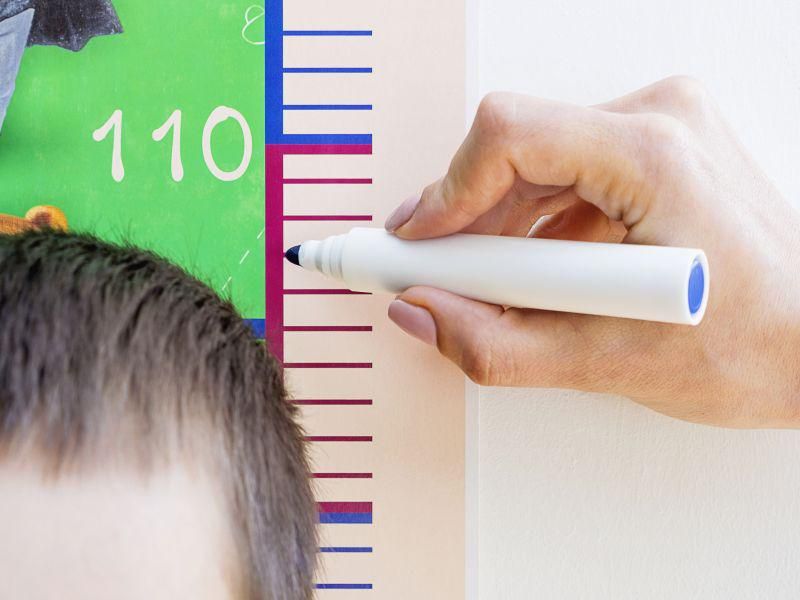THURSDAY, March 25, 2021 (HealthDay News) — A new medication may offer hope to children with achondroplasia, a rare bone growth disorder that causes very short stature coupled with disproportionate limb and trunk size.
The experimental drug is called vosoritide. By tamping down overactive growth plate signaling that impedes bone growth, the drug seeks to offer affected children the possibility of greater height and improved proportions.
“Currently, there are no treatments that are targeted at its source,” said study author Dr. Ravi Savarirayan. Left untreated, patients experience medical and functional complications, he said, including spinal column narrowing (spinal stenosis), spinal cord compression and bowed legs.
But a daily dose of the investigational drug — administered to nearly 120 children for two years — translated into height gains among patients 5 to 18 years old.
Prior to the study, the children had gained an average of 1.67 inches in height a year. But one year into the trial, yearly height gains averaged 2.23 inches. The gains continued over a second year of treatment, dipping slightly to 2.19 in additional height a year, on average.
“We found daily treatment increased growth to the rate approximating those without the condition,” said Savarirayan, a professor and clinical geneticist with the Murdoch Children’s Research Institute at Royal Children’s Hospital in Parkville, Australia.
The drug also appeared to improve body proportions and was safe and durable, meaning the benefit did not appear to wane over time.
The study team noted that achondroplasia is the most common driver of disproportionate short stature. Children with the condition tend to have short limbs and average trunk length. Their maximum height is typically under 4 feet 6 inches.
Savarirayan said the genetic condition affects roughly 360,000 people around the world, and that the drug under study is only designed to address this particular condition, not short stature in general.
Dr. Alan Rogol is professor emeritus of pediatrics and pharmacology at the University of Virginia and a former vice president of The Endocrine Society. He said, “This is the most common cause out of at least 1,000 different causes of disproportionate short stature.” But it’s critical to distinguish between the condition and efforts to treat it, on the one hand, and simply being short on the other, he added.
“Healthy short people are proportionate, and everything works,” Rogol noted. “People with this condition have very small hands and feet, a relatively large head, and have a very difficult time with their spine, especially at both ends. And they’re more likely to have serious complications, including sleep apnea, obesity and difficulty with activities of daily living and developmental delays.”
Many of those concerns can, in fact, be addressed, Rogol said. But for growth itself there has been little in the offing for achondroplasia patients.
“There is growth hormone, but it’s only approved in Japan, nowhere else, and if it is effective in making patients taller, it is a minor league effect,” he said.
“And then there’s limb lengthening, which means breaking the legs, breaking the arms, putting in a metal distractor between the two ends, and cranking it up a few tenths of a millimeter every few days,” Rogol said.
“With this, you can get limb lengthening and growth,” he acknowledged. “It’s a legitimate procedure. There are some good doctors who do this. But it usually goes on six to 12 months, and it’s a horrific procedure with tremendous side effects. It’s not anything that the faint of heart should do without some serious consideration.”
As for vosoritide, Rogol cautioned that “it’s not whether it works or not, but how well. There’s no question that the children had a height growth velocity that was greater than it was before. But the difference after a year or two is very, very small. It’s only marginally significant. So it’s a value judgment that the parents are going to have to make.”
And there are philosophical considerations as well, he added, given that there’s an argument to be made that “little people are fine as they are, are supposed to be little, and don’t need anything to be done about it.”
According to Savarirayan, vosoritide is under review by both the U.S. Food and Drug Administration and the European Medicines Agency. The research was funded by BioMarin, the drug’s maker. The findings were presented Saturday at a virtual meeting of The Endocrine Society.
Data and conclusions presented at meetings should be considered preliminary until published in a peer-reviewed medical journal.
More information
There’s more on achondroplasia at the U.S. National Center for Advancing Translational Sciences.
SOURCES: Ravi Savarirayan, MD, professor and clinical geneticist, Murdoch Children’s Research Institute at Royal Children’s Hospital in Parkville, Australia; Alan D. Rogol, MD, PhD, professor emeritus, pediatrics and pharmacology, University of Virginia, and former vice president, The Endocrine Society; The Endocrine Society, virtual annual meeting, March 22 to 23, 2021
Copyright © 2025 HealthDay. All rights reserved.

